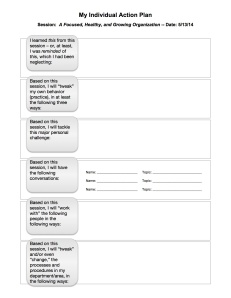Could it really be that simple?
“The secret lies with Charlotte.”
Ben Gates (Nicolas Cage), in National Treasure
——————–
We look for answers to questions/problems that vex us. And, though everything about the work world seems far more complex, maybe sometimes the answer is not found in complexity, but in simplicity itself.
Here’s one vexing problem. Why don’t people “learn” more in training sessions? Why do they go, and then leave, and little-to-nothing ever changes?
Well, a study has just been released that might have a really simple tool to help people actually learn what we wish they would learn.
The finding — at the end of a learning/training session, make time for reflecting on what was just learned.
In my observation, when I finish a training session, people are ready to leave… really, before the session is over, people are ready to leave. They rush out, check their phones, get on with their work and their lives.
The idea that they should sit still another few minutes and ponder, and reflect on what they learn, is almost beyond anyone’s comprehension.
And, yet… could it really be that simple?!
I read about this study on The Atlantic site, in Study: You Really Can ‘Work Smarter, Not Harder’ – Research shows that reflecting after learning something new makes it stick in your brain by Nanette Fondas. Here’s the key paragraph (the whole article will help reinforce the finding):
Learning is more effective if a lesson or experience is deliberately coupled with time spent thinking about what was just presented, a new study shows. In “Learning by Thinking: How Reflection Aids Performance,” a team of researchers from HEC Paris, Harvard Business School, and the University of North Carolina describe what they call the first empirical test of the effect of reflection on learning. By “reflection,” they mean taking time after a lesson to synthesize, abstract, or articulate the important points.
So, my simple suggestion to anyone and everyone is that the next time you go to a training/learning session, at the end of the session, sit still and ponder – reflect on what you have learned – and really think about what you will do differently after the session.
For some time, I have tried to “help” this process with an exercise I developed. I just intuitively felt that this was the right thing to do. But, after a “good start” to my practice, I have evolved into just handing out my sheet for this process at the end, and asking folks to fill it out on their own later. After reading about this study, I am going back to my earlier practice: I will save the last 7-10 minutes of a training/learning session for silence, so that participants can fill out this sheet
The form I developed has a touch of Susan Scott on it (the “what conversations should I have” section), and plenty of prompts for pondering and reflection. It really is adaptable to almost any session, any subject. Take a look. Feel free to copy it and use it yourself. If you are going to a training/learning session, print it out for yourself, and have your own private “reflection session.” If you are leading a session, maybe it would be good to use this (or, develop your own “reflection tool”), and save time at the end of the session for people to reflect.
I call it “My Individual Action Plan.” Here it is – take a look (I always put the “topic/title” for the session at the top, and the date. This was from a session I led this week in Dallas for an executive team of a mid-size organization. You can of course put your own topic/title on the sheet when you use it).

